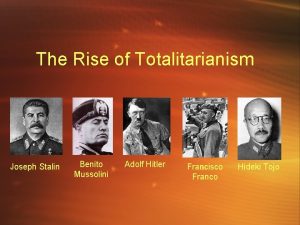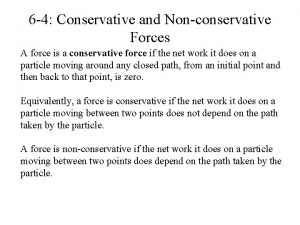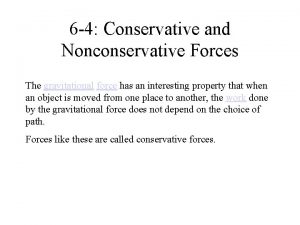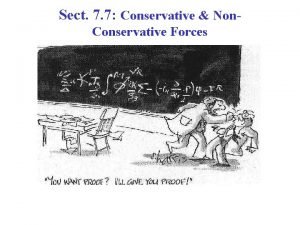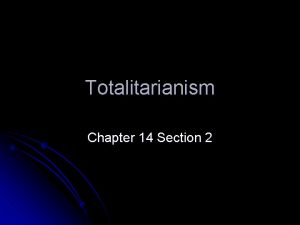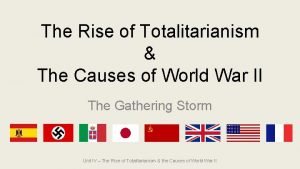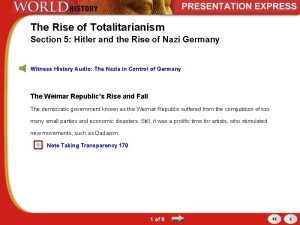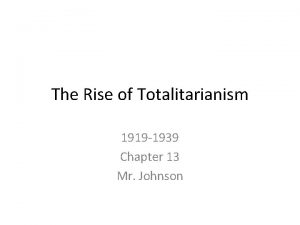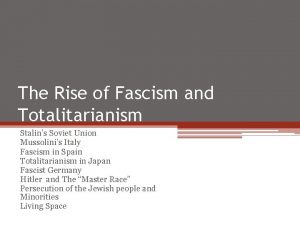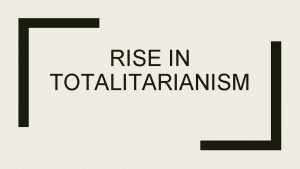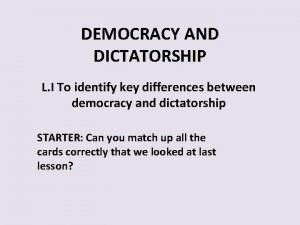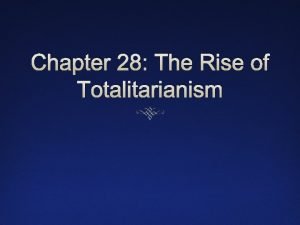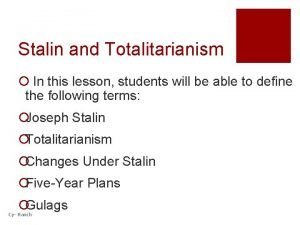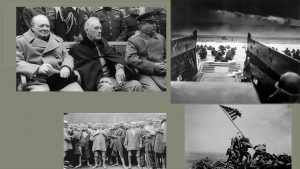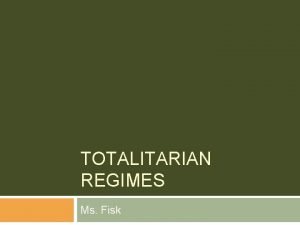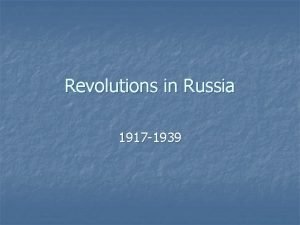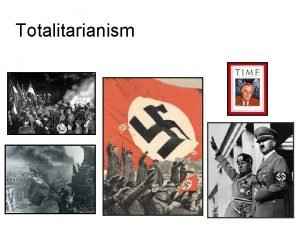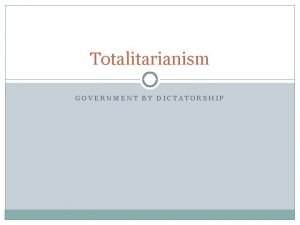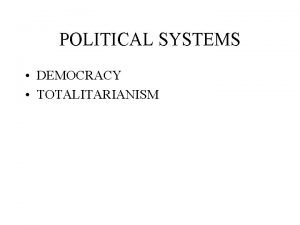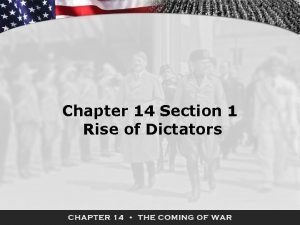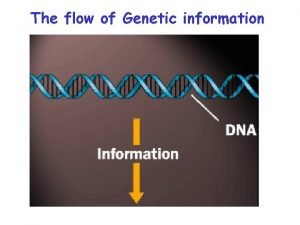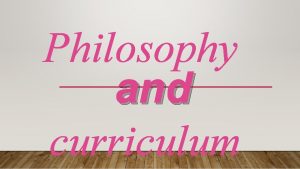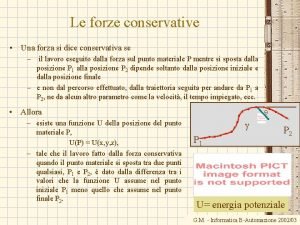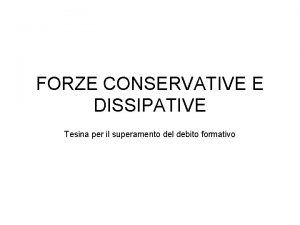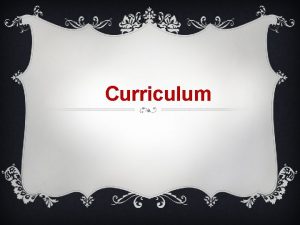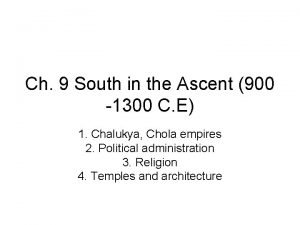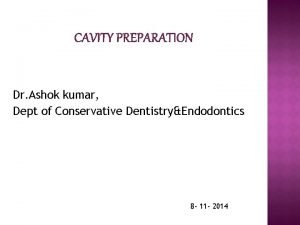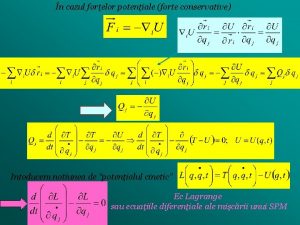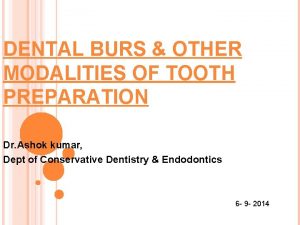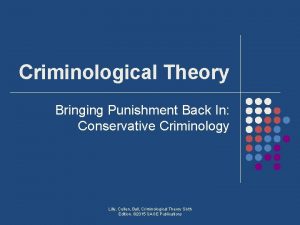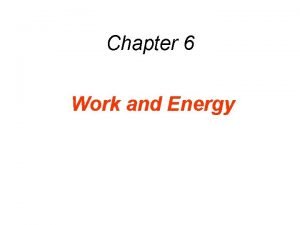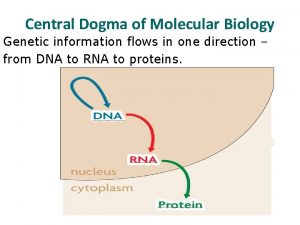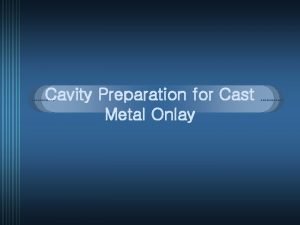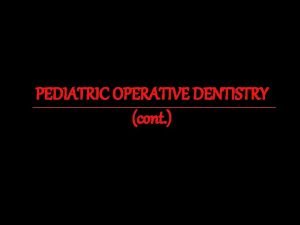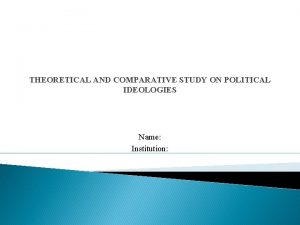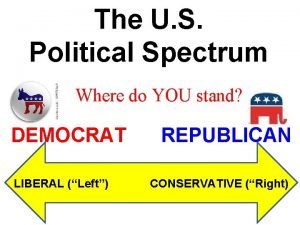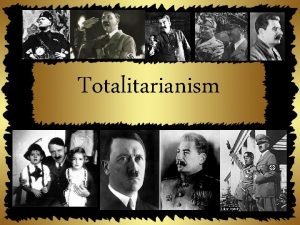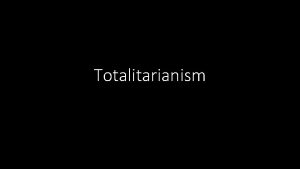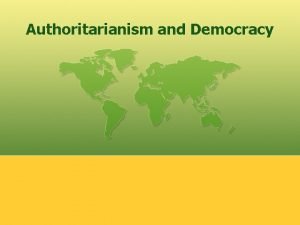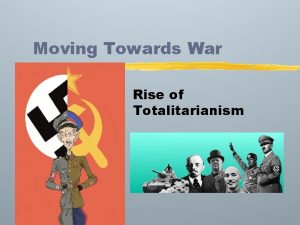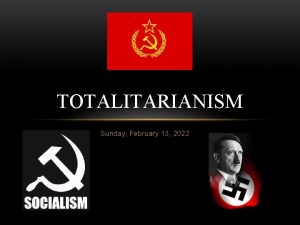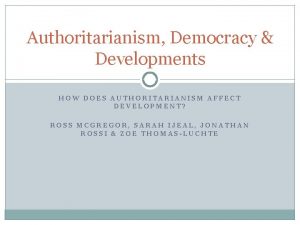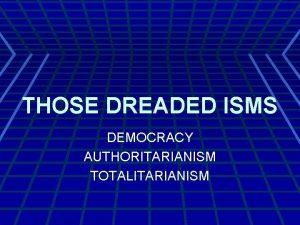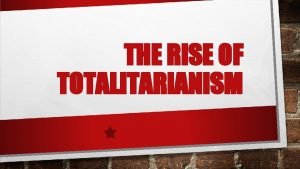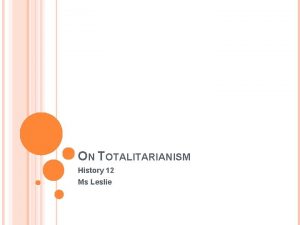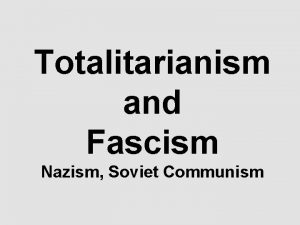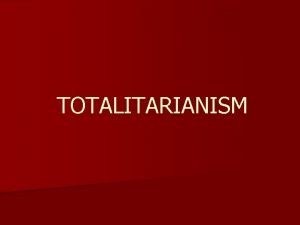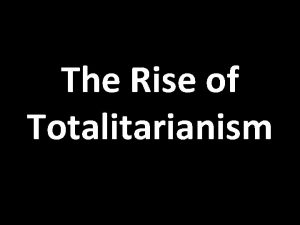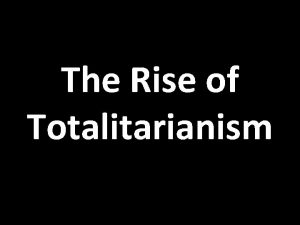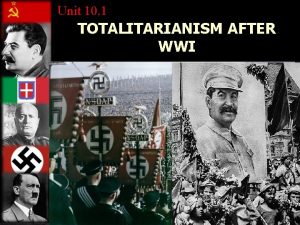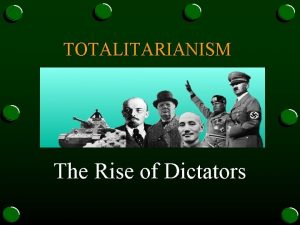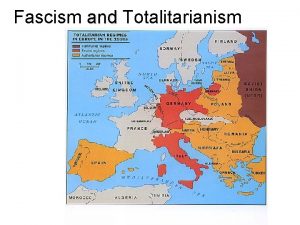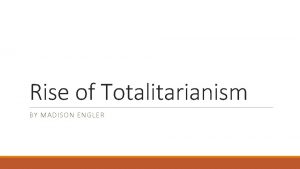Totalitarianism Conservative Authoritarianism Conservative authoritarianism traditional form of




















































- Slides: 52

Totalitarianism

Conservative Authoritarianism • Conservative authoritarianism: traditional form of antidemocratic government in Europe • (e. g. , Metternich, Catherine the Great) • Prevented major changes undermining existing social order • Popular participation in government forbidden or severely limited – This is a stark contrast to 20 th century totalitarianism where people were expected to participate in the system and actively support the regime • Limited in power and in objectives (usually sought status quo)

Conservative Authoritarianism • Lacked modern technology and communications and could not control many aspects of their subjects’ lives. – Usually limited demands to taxes, army recruits, and passive acceptance of the regime • Conservative Authoritarianism revived after WWI, especially in less developed Eastern Europe and Spain and Portugal; only Czechoslovakia remained democratic. • Great Depression ended various levels of democracy in Austria, Bulgaria, Rumania, Greece, Estonia, and Latvia

Totalitarianism • Totalitarianism: dictatorship that tried to control every aspect of the lives of the people. • New technology made this possible: radio, automobile, telephone – Wiretaps, faster communication between officials, propaganda, increased mobility • Tools of totalitarianism: censorship, indoctrination, terror • Existed first in Russia, then Italy? , Japan and Germany (sought expansion, except Russia)

What is Fascism? Glorification of the State Militaristic Society Single Party Dictatorship Fascism Pro Capitalist when it serves state Corporate state in regards to industry Emphasizes inequality in HUMANS Peace is weak, Expansion a must Condemns Democracy Advocates Social Darwinism Aggressive Nationalism

How does fascism differ from Communism? • Government: • Economy • Foreign policy • Ideas of Imperialism • Ultimate goal in regards to domestic disputes • Social Policy

Stalinist Russia • Power struggle ensued after Lenin’s death in 1924: he left no chosen successor • Joseph Stalin believed in "Socialism in one Country": first, Russia had to be strong • Establishment of a Socialist economy without the aid of the West • Leon Trotsky believed in "permanent revolution": continuing a world revolution • Party leaders believed Trotsky was too idealistic; Russia first had to survive • Stalin gained control in 1927 and had total control by 1929; Trotsky exiled and killed in Mexico city 1940

Stalin’s Five Year Plans • Entire Politburo from Lenin's time was eventually purged leaving Stalin in absolute control. The 5 -year plans • "Revolution from above" (1 st Five Year Plan), 1928; marked end of NEP • Objectives: – Total industrial output to increase by 250%; steel by 300%; agriculture by 150% – 1/5 of peasants were scheduled to give up their private plots and join collective farms – “We are 50 or 100 years behind the advanced countries. We must make good this distance in 10 years. Either we do it or we shall go under. ”

Stalin’s Five Year Plans • Results: steel up 400% (now 2 nd largest steel producer in Europe); oil up 300%; massive urbanization (25 million people moved to cities) • Costs: quality of goods suspect; standard of living did not rise

Stalin’s Five Year Plans • Collectivization was the greatest of all costs • Purpose: bring peasantry under absolute control of the communist state • Consolidation of individual peasant farms into large, state controlled enterprises. • Farmers paid according to amount of work; portion of harvest paid to gov't – Had to meet a quota for gov’t before feeding themselves • Goals: – Use of machines in farm production, to free more people to work in industry – Gov't control over production – Extend socialism to countryside

Stalin’s Collectives • Results: – Opposed by farmers as it placed them in a bound situation like the mirs. – Kulaks, wealthiest peasants, offered greatest resistance to collectivization – Stalin ordered party workers to "liquidate them as a class. " – Agricultural output no greater than in 1913 – By 1933, 60% of peasant families were on collective farms; 93% by 1938. – Eventually, the state was assured of grain for bread for urban workers who were more important politically than the peasants.

Holomodor “Death by Forced Starvation” (Ukrainian) • • • Ukrainian genocide that began in 1929. Man made famine by Stalin’s government in reaction against the peasant and kulak response to collectivization and/or against Ukrainian nationalism Characteristics: – Massive waves of deadly deportations of Ukraine's most successful farmers, the Kulaks – Deportations and executions of Ukraine's religious, intellectual and cultural leaders – destruction of Ukraine's political leadership, the resettlement of Ukraine's depopulated areas with other ethnic groups, the prosecution of those who dared to speak of the famine publicly, and the consistent blatant denial of famine by the Soviet regime. – Early estimates of the death toll by scholars and government officials varied greatly; anywhere from 1. 8 to 12 million ethnic Ukrainians were said to have perished as a result of the famine. • Why do you think it is so hard to estimate a specific number of casualties?

Holomodor “Death by Forced Starvation” (Ukrainian) • On November 28 th 2006, the Verkhovna Rada (Parliament of Ukraine) passed a decree defining the Holodomor as a deliberate Act of Genocide. • Although the Russian government continues to call Ukraine's depiction of the famine a "one sided falsification of history, " it is recognized as genocide by approximately two dozen nations, and is now the focus of considerable international research and documentation.

Holomodor DC Memorial

Stalin’s Government • Central Committee was the apex of Soviet power (about 70 people in 1930 s) • Politburo: About a dozen members; dominated discussions of policy and personnel • General Secretary: highest position of power; created by Stalin

Propaganda Campaign • Purpose: To glorify work to soviet people an at tempt to encourage worker productivity – Used technology for propaganda – Newspapers (esp. Pravda), films, and radio broadcasts emphasized socialist achievements and capitalist plots. • Sergei Eisenstein: patriotic Russian filmmaker • Writers & artists expected to glorify Stalin and the state; work was closely monitored – “Socialist Realism” • Religion was persecuted: Stalin hoped to turn churches into "museums of atheism"


Benefits Under Stalin • Benefits for workers: – Old age pensions, free medical services, free education, and day care centers for children – Education was key to improving one’s position: specialized skills and technical education. • Many Russians saw themselves building world’s first socialist society while capitalism crumbled during the Great Depression • USSR attracted many disillusioned Westerners to communism in the 1930 s.

Benefits Under Stalin Women • Russian Revolution immediately proclaimed complete equality of rights for women. • In 1920 s divorce and abortion made easily available. • Women urged to work outside the home and liberate themselves sexually. • Many women worked as professionals and in universities. • Women still expected to do household chores in off hours as Soviet men considered home and children women’s responsibility. • Men continued to monopolize the best jobs. • Rapid change and economic hardship led to many broken families.

The Great Terror (1934 -38) • • • First directed against peasants after 1929, terror used increasingly on leading Communists, powerful administrators, and ordinary people, often for no apparent reason. The "Great Terror" resulted in 8 million arrests Show trials used eradicate "enemies of the people" (usually ex party members) Late 1930 s, dozens of Old Bolsheviks tried and executed (Lenin's closest followers) Purges: 40, 000 army officers were expelled or liquidated (weakened USSR in WWII) Millions of citizens were killed, died in labor camps (gulags), or simply disappeared

Fascist Italy • Causes for rise of fascism – In early 20 th century, Italy was a liberal state with civil rights and constitutional monarchy. – Versailles Treaty: Italian nationalists angry that Italy did not receive any Austrian or Ottoman territory, (Italia Irredenta) or Germany’s African colonies as promised. – Depression in 1919 caused nationwide strikes and class tension – Wealthy classes fearful of communist revolution looked to strong anti communist leader • • By 1921 revolutionary socialists, conservatives and property owners were all opposed to liberal parliamentary government. Fascism in Italy eventually a combination of conservative authoritarianism and modern totalitarianism (although not as extreme as Russia or Germany)

Benito Mussolini (1883 -1945) • • Editor of a socialist newspaper yet was a nationalist. Organized the Fascist party Combination of socialism and nationalism: territorial expansion, benefits for workers, and land reform for peasants. Named after fasces: the rods carried by Imperial Roman officials as symbols of power. Initially, failed to succeed because of competition from well organized Socialists. 1920, Mussolini gained support of conservative classes and frightened middle class for anti Socialist rhetoric; abandoned his socialist programs. Blackshirts (squadristi): Paramilitary forces attacked Communists, socialists, and other enemies of the fascist program (later, Hitler's "Brown Shirts" followed this example)

March on Rome • • • March on Rome, October 1922: led to Mussolini taking power Mussolini demanded resignation of existing gov’t and his own appointment by the king. Large group of Fascists marched on Rome to threaten king to accept Mussolini's demands. Government collapsed; Mussolini received right to organize a new cabinet (government). Victor Emmanuel III gave him dictatorial powers for 1 year to end nation’s social unrest.

Corporate State • • • Corporate State (syndicalist-corporate system) was the economic basis for Italian fascism. “Everything in the state, nothing outside the state, nothing against the state. ” By 1928, all independent labor unions organized into governmentcontrolled syndicates Established organizations of workers and employers and outlawed strikes and walkouts. Created corporations which coordinated activities between workeremployer syndicates. Authority from the top, unlike socialist corporate states where workers made decisions.

Mussolini = il Duce • • • Right to vote severely limited. All candidates for Italian parliament selected by Fascist party. Gov’t ruled by decree. Dedicated fascists put in control of schools. Created fascist youth movement, labor unions, and other fascist organizations: Dopolavoro (After Work) and Balilla (Fascist Youth Organization) failed to regulate leisure time.

Fascist Italy • Mussolini never became all powerful • Failed in attempt to “Fascistize” Italian society by controlling leisure time • Old power structure of conservatives, military, and church remained intact. • Mussolini never attempted to purge conservative classes. • He propagandized and controlled labor but left big business to regulate itself. • No land reform occurred • Did not establish ruthless police state (only 23 political prisoners executed bet. 1926 1944) • Racial laws not passed until 1938 and savage persecution of Jews not until late in WWII when Italy was under Nazi control.

Women • Divorce abolished and women told to stay home and procreate. • Decreed a special tax on bachelors in 1934. • 1938, women limited by law to a maximum of 10% of better paying jobs in industry & gov't

Accomplishments Under Mussolini • • Internal improvements made such as electrification and roadbuilding. More efficient municipal governing. Suppression of the Mafia Improvement of the justice system (except for “enemies of the state”) Lateran Pact, 1929, resulted in reconciliation with the papacy Vatican recognized as a tiny independent state; received $92 mil for seized church lands In return, Pope Pius XII recognized legitimacy of the Italian state.

Failures & Legacy • Italian democracy destroyed • Terrorism became a state policy. • Poor industrial growth due to militarism and colonialism. • Disastrous wars resulted from attempt to recapture imperialistic glories of Ancient Rome.

The Rise of Nazi Germany • Roots of Nazism: Extreme nationalism + racism = Nazism • Hyper nationalism fed the impulse of conquer other nations • Racial Superiority of the Aryan Race

Adolf Hitler • Adolf Hitler became leader of National German Workers Party (NAZI) after WWI • S. A. : "Brown Shirts" terrorized political opponents on the streets • Beer Hall Putsch, 1923: Hitler failed to overthrow Bavaria and sentenced to 1 year in jail • Hitler realized he'd have to take control of Germany legally, not through revolution

Mein Kampf • Mein Kampf, 1923 written while in jail: became the blueprint for Hitler's future plans – lebensraum (“living space”): Germans should expand east, liquidate the Jews and turn the Slavs into slave labor – anti Semitism: Hitler blamed the Jews for Germany's political and economic problems – Leader dictator, Fuhrer, would have unlimited arbitrary power

Fall of the Weimar • the result of the Great Depression – Unemployment reached 43% by end of 1932 – Hitler began promising German voters economic, political, and military salvation. – Hitler promised big business leaders he would restore the economy by breaking Germany’s strong labor movement and reducing workers’ wages if necessary. • • • Hitler assured top army leaders that the Nazis would reject the Versailles Treaty and rearm Germany. Nazis also appealed to German youth: 40% of party under age 30 in 1931; 67% under 40 1930, Chancellor gained permission from President Hindenburg for emergency rule by decree Struggle between Social Democrats & Communists contributed to breakdown of gov't. Nazi's won largest percentage of votes in the Reichstag in 1933 elections Hitler becomes Chancellor on January 30, 1933; appointed by Hindenburg.

Third Reich (1933 -1945) • • • Hitler consolidates power Reichstag fire occurred during violent electoral campaign: used by Nazis to crack down on communists Enabling Act (March 1933) passed by Reichstag – Gleichschaltung (“coordination”) Gave Hitler absolute dictatorial power four years Only the Nazi party was legal Hitler outlawed strikes and abolished independent labor unions. Publishers, universities, and writers brought into line Democratic, socialist, and Jewish literature put on blacklists. Students and professors burned forbidden books in public squares. Modern art and architecture was prohibited ("degenerate art") Religion: Confessing Church

Rallies

Third Reich (1933 -1945) • • Joseph Goebbles: minister of propaganda effectively glorified Hitler and the Nazi state “Night of Long Knives” (June 1934) – Hitler realized the army and big business were suspicious of the S. A. – Hitler’s elite personal guard—the SS —arrested and shot without trial about 1, 000 SA leaders and other political enemies. • • • S. S. grew dramatically in influence as Hitler's private army and secret police Led by Heinrich Himmler SS joined with the political police, the Gestapo, to expand its network of special courts and concentration camps.

Hitler’s Henchmen Hermann Goering Successor to Hilter and commander of the Luftwaffe Reinhard Heydrich Head of the Security Main Office SS, Gestapo, Kripo Chaired Wannsee Conference Heinrich Himmler Head of SS and later Gestapo as well Rudolf Höß Rudolf Hess Commandant of Auschwitz Deputy to Nazi Party Adolf Eichmann Lt. Colonel, Architect of the Holocaust Albert Speer, Architect of the Third Reich Joseph Goebbels Propaganda Minister

Hitler Youth • Hitler Youth: Nazis indoctrinated German youths along • Children encouraged to turn in teachers or even their parents if they seemed disloyal to the Reich

Degenerate Art • Term adopted by the Nazi regime in Germany to describe Modern art. Such art was banned on the grounds that it was un German, Jewish, or Communist in nature, and those identified as degenerate artists were subjected to sanctions.

Reichskonkordat • • • negotiated between the Vatican and the emergent Nazi Germany. It was signed on 20 July 1933 by Cardinal Secretary of State (and later Pope Pius XII) Eugenio Pacelli on behalf of Pope Pius XI and Vice Chancellor Franz von Papen on behalf of President Paul von Hindenburg and the German government. It was ratified September 10, 1933 and it has been in force from that date onward. – The treaty guarantees the rights of the Roman Catholic Church in Germany. – The treaty also requires all clergy to abstain from working in and for political parties. Nazi breaches of the agreement began almost as soon as it had been signed and intensified afterwards leading to protest from the Church including in the 1937 Mit brennender Sorge encyclical of Pope Pius XI. – The Nazis planned to eliminate the Church's influence by restricting its organizations to purely religious activities. Example – Mandatory Hitler Youth meetings on Sundays

Persecution of the Jews • On April 7 1933, after Hitler is Chancellor he passes the Law for the Restoration of a Professional Civil Service which purged Jews and others from the civil service. – This included judges, professors, and school teachers • On April 25 th a “numbers clause” was amended to the law to restrict the percentage of Jewish students who could attend the University. – As the purges continued other professions dismissed Jews from the arts and press as well. – By removing them from these positions, they would not be in the position to influence German society. – Propaganda was used to justify removing the rights of Jews to practice law as well as dismissing Jewish doctors from the medical board.

Nuremburg Laws • • They were announced at the annual Nuremburg Rally The first law identified as the Law For the Protection of German and German Honor contain seven sections. – Section 1 made marriages between Jews and Germans illegal – section 2 forbade sexual relations between Germans and Jews. – Section 3 prohibited any German female under the age of 45 to serve in the home of a Jew. – Section 4 prohibited Jews from displaying the Reich national flag or its colors, but they were allowed to display Jewish colors. This act would inadvertently help to identify those who were Jewish and therefore continued to single them out from society. – Section 5 described the penalties for violating sections 2 4. – Section 6 and seven described the enforcement and the effective date of these laws. This action segregated the Jews from society by written law. This racial law combined with the next law, the citizen ship law, will completely separate the Jews as part of German society.

Nuremburg Laws • The second law of the Nuremburg Laws was the Reich Citizenship law. This law contains three articles. There was now a new distinction between Reich citizens and just nationals. – Article one states that each citizen of the German Reich has obligations toward the state. – Article 2 states what is required to become a German citizen. This included one who is of “German or Kindred blood. ” These will be issued Reich citizenship papers and will enjoy full political rights. – According to the law, those with three Jewish grandparents; those with two grandparents and practiced the faith; those married to a Jew, or those were the legitimate or illegitimate offspring of at least one Jewish parent were considered Jewish under the law. – Article 3 had stripped the Jews of their citizenship. Now they were outside the protection of Reich law. Therefore, any actions taken against them could in essence be justified because they were not citizens, and therefore are not protected.

Propaganda • Jews, like all other German citizens, were required to carry identity cards, but their cards were stamped with a red “J. ” This allowed police to easily identify them. • The Nazis used propaganda to promote their anti Semitic ideas. • One such book was the children’s book, The Poisonous Mushroom.

Anti-Semitic Propaganda

Kristallnacht • Kristallnacht (“The Night of Broken Glass”) 1938 • Using assassination of a German diplomat in Paris by young Jewish boy as pretense, Hitler ordered an attack on Jewish communities. • Well organized wave of violence destroyed homes, synagogues, and businesses. • Thousands of Jews were arrested and made to pay for the damage.

T-4 Euthanasia Program • The aryanization process went full speed ahead with the beginning of the war in September 1939. • The authorization of the “euthanasia program” or T 4, put into practice of system of killing “lives unworthy of living. ” • These individuals were those who were handicapped or had some mental or physical disability. • This is an important point of fact because if the state could justify killing “those unworthy of living, ” in this case the disabled, then if they portray other groups, such as the Jews as, “those unworthy of living, ” then their death could be justified.

Persecution • Nazis targeted other individuals and groups in addition to the Jews: • Gypsies (Sinti and Roma) • Homosexual men • Jehovah’s Witness • Handicapped Germans • Poles • Political dissidents

The Holocaust • Holocaust: 6 million European Jews eventually killed during WWII ("Final Solution") (to be studied next chapter)

German Economic Recovery • • • German economic recovery contributed to Hitler's soaring popularity Hitler delivered on his economic promise of “work and bread. ” Large public works program started to get Germany out of the depression. Included superhighways (autobahn), offices, gigantic sports stadiums, and public housing. 1936, Germany began rearmament and government spending began to focus on the military. Results: – Unemployment dropped from 6 million in January 1933, to about one million in late 1936. – 1938, shortage of workers; women took many jobs earlier denied by antifeminist Nazis. – By 1938 standard of living for the average employed worker increased moderately. – Profits of business rose sharply.

Nazi society: was there really a social revolution? • Quantitative studies show that well educated classes held on to most of their advantages. • Only a modest social leveling occurred. • Like Italy, women were viewed as housewives and mothers. • Only in wartime were large numbers of women mobilized for work in offices & factories.

NEXT World War II: The Nightmare Begins
 Rise of totalitarianism
Rise of totalitarianism Force conservative et non conservative
Force conservative et non conservative A motorcyclist is trying to leap across the canyon
A motorcyclist is trying to leap across the canyon Gravitational force is conservative
Gravitational force is conservative Conservative and non conservative force
Conservative and non conservative force Chapter 14 section 2 totalitarianism
Chapter 14 section 2 totalitarianism Pearl harbor date
Pearl harbor date The rise of totalitarianism section 5 quiz
The rise of totalitarianism section 5 quiz Chapter 13 the rise of totalitarianism
Chapter 13 the rise of totalitarianism Fascism vs totalitarianism
Fascism vs totalitarianism Fascism vs totalitarianism
Fascism vs totalitarianism Democracy vs. dictatorship venn diagram
Democracy vs. dictatorship venn diagram The rise of totalitarianism section 1 quiz
The rise of totalitarianism section 1 quiz Totalitarianism pictoword
Totalitarianism pictoword Fascism vs totalitarianism
Fascism vs totalitarianism Totalitarianism lesson plan
Totalitarianism lesson plan The that hitler war
The that hitler war Traits of totalitarianism
Traits of totalitarianism Why did the czars resist change?
Why did the czars resist change? Totalitarianism
Totalitarianism Pros and cons of dictatorship
Pros and cons of dictatorship Secular totalitarianism
Secular totalitarianism Chapter 14 section 1 dictators and war
Chapter 14 section 1 dictators and war Present continuous affirmative form
Present continuous affirmative form Haiku
Haiku Curl formula in spherical coordinates
Curl formula in spherical coordinates Force conservative
Force conservative Thinking algebraically stock market game answer key
Thinking algebraically stock market game answer key 3-5 exonuclease vs 5-3 exonuclease
3-5 exonuclease vs 5-3 exonuclease The stock market game activity sheet 2 answers
The stock market game activity sheet 2 answers Perennialism characteristics
Perennialism characteristics T shaped matrix band
T shaped matrix band Il lavoro è una forza conservativa
Il lavoro è una forza conservativa Forze dissipative e conservative
Forze dissipative e conservative What is curriculum construction
What is curriculum construction Conservative forces
Conservative forces Conservative america in the ascent
Conservative america in the ascent Self cleansable area of tooth
Self cleansable area of tooth Physics 03-02 potential energy and conservative forces
Physics 03-02 potential energy and conservative forces Forelor
Forelor Why electric force is conservative
Why electric force is conservative What is a dental bur
What is a dental bur Conservative criminology
Conservative criminology Work energy
Work energy Conservative missense mutation
Conservative missense mutation Metal onlay preparation
Metal onlay preparation Cast metal restorations
Cast metal restorations Conservative mixing
Conservative mixing Isthmus in conservative dentistry
Isthmus in conservative dentistry Rotary cutting instruments in operative dentistry
Rotary cutting instruments in operative dentistry Conservative comparative and superlative
Conservative comparative and superlative What is a moderate
What is a moderate The conservative tide
The conservative tide
